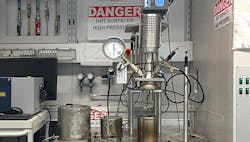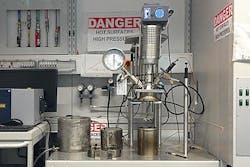Water Makes Polymerization Greener
A synthesis process for pyrrone polymers and polybenzimidazoles avoids the toxic solvents traditionally used and instead relies on hot water, report researchers at the Technical University of Vienna, Vienna. They achieved the syntheses at 17 bar and 200°C in a 1-L steel reactor (Figure 1).
“Little is known today about the hydrothermal generation of organic high-performance polymers. I am truly convinced that there is a lot to explore and that a plethora of intriguing and novel materials can be generated by taking advantage of the sheer power of hot water,” says Miriam Unterlass, head of the research group for organic high-performance materials at the university.
A recent issue of Angewandte Chemie contains an article that provides a mechanistic discussion of the polymer formation process.
Figure 1. Polymerization took place at 17 bar and 200°C in a 1-L steel reactor. Source: Miriam Unterlass/TU Wien.
However, the researchers have yet to fully define the exact role of high temperature water in the reactions, despite morphology, crystallinity and thermal behavior studies giving some clues to the mechanism of polymer formation.
“It clearly would be interesting to perform experiments where we can directly make in-situ observations and this is definitely something that we want to pursue in the near future,” she adds.
Scaleup of the chemistry should not pose severe challenges, reckons Unterlass, because the polymerization reactions are highly stable and not sensitive to moderate variations in pH, temperature, pressure or reaction time. “They only require suitable starting materials, water, an autoclave and sufficiently high temperatures,” she explains.
Synthesizing products that require more extreme conditions such as 350°C and 165 bar would necessitate modifications to the reactor and process, she feels, to lower the autogenously generated pressures — perhaps by using catalysts and co-solvents.
“However, most reactions work at temperatures between 180°C and 250°C, which roughly corresponds to pressures between 10 and 40 bar. These conditions shouldn’t be a problem for industrial implementation,” Unterlass notes.
One challenge, though, is to find potential applications for pyrrone polymers which at the moment don’t have a commercial use. The research group now is exploring their use as electrode materials.
Seveal years ago, the same team managed to synthesize polyimides hydrothermally. This led to establishing a spin-off company, UGP Materials, Vienna, to commercialize that synthesis. Confidentiality requirements prevent Unterlass, who is chief scientific officer of the company, from revealing details either about ongoing collaborations with industrial partners or their possible future projects.

